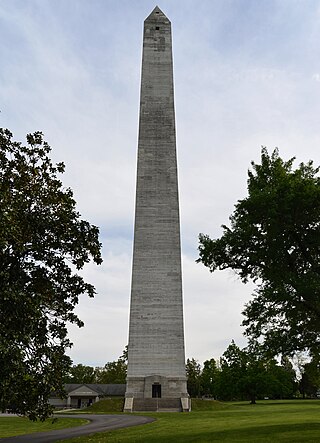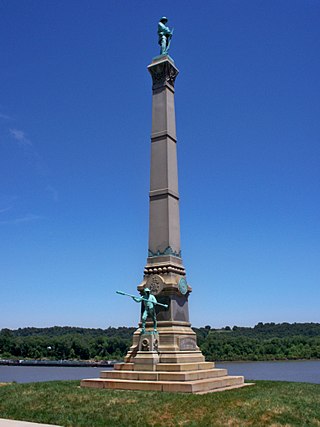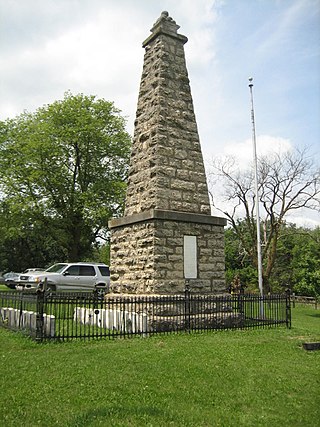
Mayfield is a home rule–class city and the county seat of Graves County, Kentucky, United States. The population was 10,017 as of the 2020 United States Census.

Green-Wood Cemetery is a 478-acre (193 ha) cemetery in the western portion of Brooklyn, New York City. The cemetery is located between South Slope/Greenwood Heights, Park Slope, Windsor Terrace, Borough Park, Kensington, and Sunset Park, and lies several blocks southwest of Prospect Park. Its boundaries include, among other streets, 20th Street to the northeast, Fifth Avenue to the northwest, 36th and 37th Streets to the southwest, Fort Hamilton Parkway to the south, and McDonald Avenue to the east.

The Indiana State Soldiers and Sailors Monument is a 284 ft 6 in (86.72 m) tall neoclassical monument built on Monument Circle, a circular, brick-paved street that intersects Meridian and Market streets in the center of downtown Indianapolis, Indiana. In the years since its public dedication on May 15, 1902, the monument has become an iconic symbol of Indianapolis, the state capital of Indiana. It was added to the National Register of Historic Places on February 13, 1973 and was included in an expansion of the Indiana World War Memorial Plaza National Historic Landmark District in December 2016. It is located in the Washington Street-Monument Circle Historic District. It is also the largest outdoor memorial and the largest of its kind in Indiana.

The Jefferson Davis Monument State Historic Site is a Kentucky state park commemorating the birthplace of Jefferson Davis, the president of the Confederate States of America, in Fairview, Kentucky. The site's focal point is a 351-foot (107.0 m) concrete obelisk. In 1973, it was believed to be the fourth-tallest monument in the United States and the tallest concrete-cast one.

The Confederate Monument in Louisville is a 70-foot-tall monument formerly adjacent to and surrounded by the University of Louisville Belknap Campus in Louisville, Kentucky, United States. Relocation of the monument to Brandenburg, Kentucky, along the town's riverfront began November 2016, and was completed in mid-December. The granite and bronze structure was erected in 1895 by the Muldoon Monument Company with funds raised by the Kentucky Woman's Confederate Monument Association. The monument commemorates the sacrifice of Confederate veterans who died in the American Civil War.

Old Gray Cemetery is the second-oldest cemetery in Knoxville, Tennessee, United States. Established in 1850, the 13.47-acre (5.45 ha) cemetery contains the graves of some of Knoxville's most influential citizens, ranging from politicians and soldiers, to artists and activists. The cemetery is also noted for the Victorian era marble sculpture and elaborate carvings adorning many of the grave markers and headstones. In 1996, the cemetery was added to the National Register of Historic Places.

Kellogg's Grove is an area in western Stephenson County, Illinois, United States near the present-day unincorporated town of Kent. The grove is considered historically significant because it was the site of two minor skirmishes during the Black Hawk War in 1832. Today, most of the grove is privately owned but 1.5 acres (6,100 m2) are allocated as a park owned by Stephenson County. While most of the battle occurred on what is today private property the park contains a monument dedicated to the battle and cemetery with the graves of several militia members killed during the skirmish at Kellogg's Grove. The cemetery also holds the graves of those killed in other area battles. The Kellogg's Grove battle site was added to the U.S. National Register of Historic Places in 1978.

The Confederate Monument of Bowling Green, in Bowling Green, Kentucky, is among the sixty-one monuments of the Civil War Monuments of Kentucky Multiple Property Submission, all of which became part of the National Register of Historic Places on July 17, 1997. It is within Bowling Green's Fairview Cemetery, on the east side of the old/northern side of the cemetery.

Paris Cemetery is located along South Main Street in Paris, Kentucky, United States. Incorporated on January 30, 1847, the cemetery is owned and operated by the Paris Cemetery Company. When it first opened, many families re-interred their dead in the new cemetery.

The Colored Soldiers Monument in Frankfort, Kentucky's Green Hill Cemetery, at the junction of US 60 and US 421, is the only Kentucky monument honoring black soldiers that participated in the American Civil War, and one of only four in the entire United States. Erected by the Woman's Relief Corps No. 8, an auxiliary of the Grand Army of the Republic, it was unveiled on July 4, 1924. The only other monument built by GAR in Kentucky is the GAR Monument in Covington.

The Confederate Memorial Fountain in Hopkinsville, Kentucky is a monument dedicated in October 1911. It is on the National Register of Historic Places.

The Confederate Monument in Perryville is a historic monument located by the visitor center of the Perryville Battlefield State Historic Site, in the vicinity of Perryville, Kentucky, in Boyle County, Kentucky, USA. It was built in 1902, forty years after the Battle of Perryville, the bloodiest battle in Kentucky history, on October 8, 1862. In total, 532 Confederates died at the battle, but it is unknown how many of this number are buried here. A small cemetery is by the monument; local farmers had to bury the Confederate dead as the Confederate Army, although victorious in the battle, had to leave Perryville quickly, and hogs were beginning to feast on the soldiers' remains.

The Colonel Robert A. Smith Monument, located in Hart County, Kentucky, is a monument related to the American Civil War, listed on the National Register of Historic Places. It was built in the memory of Colonel Robert A. Smith and the members of the 10th Mississippi Infantry Regiment who died in the service of the Confederate States of America on September 14, 1862, at the Battle of Munfordville.

The Confederate Memorial Gates in Mayfield are historical monuments at the entrances to Maplewood Cemetery in Mayfield, Kentucky. The monuments were the second monument in Mayfield established by the United Daughters of the Confederacy; the first being the Confederate Memorial in Mayfield in downtown Mayfield. The gates were the third choice for monuments, chosen mostly due to their relatively low cost. The UDC intended them to not only be a monument to the residents of Graves County who served the Confederate States of America, but also a civic improvement.

The Confederate Memorial in Mayfield is a commemorative monument and fountain located on the courthouse lawn in downtown Mayfield, Kentucky.

The Confederate Monument in Murray is a statue located in the northeast corner of the Calloway County Courthouse in Murray, Kentucky. It commemorates the 800 citizens of the county who served in the Confederate Army during the American Civil War, and is one of several Confederate monuments in Kentucky featuring Robert E. Lee. There is another one in Bardstown KY. Despite recent controversy, the Calloway County Fiscal Court voted to keep the statue on its grounds in July 2020.

The Confederate Memorial includes a 6-foot-tall (1.8 m) Confederate soldier statue atop an arch anchored in the Fulton, Kentucky Fairview Cemetery. Funded in 1902 by the Colonel Ed Crossland Chapter No. 347 of the United Daughters of the Confederacy, the historic monument is the only such monument in Kentucky to feature an arched base, made of rough-hewn limestone.

The Confederate Memorial in Nicholasville is a historic statue created in the Jim Crow era and located on the Jessamine County courthouse lawn in Nicholasville, Kentucky, ten miles south of Lexington, Kentucky.

Zephyr is a public sculpture created by artist Steve Wooldridge in 1998. It is located southeast of the Indiana University-Purdue University Indianapolis (IUPUI) University Library and north of New York Street on IUPUI's campus. The overall dimensions of this stainless steel sculpture are 13 feet (4.0 m) tall, 2 feet (0.61 m) long, and 10 feet (3.0 m) wide.

A statue of Frederick Douglass sculpted by Sidney W. Edwards, sometimes called the Frederick Douglass Monument, was installed in Rochester, New York in 1899 after it was commissioned by the African-American activist John W. Thompson. According to Visualising Slavery: Art Across the African Diaspora, it was the first statue in the United States that memorialized a specific African-American person.






























